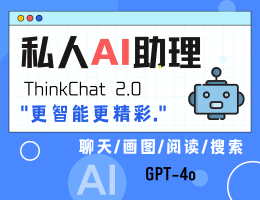# MyBatis进阶
[TOC]
## 导学
在之前的学习中,我们使用MyBatis进行了数据的CRUD操作,而且还学习了它里面一些开发小技巧。那么在本节课程中,我们将要学习MyBatis的一些高级特性。
## MyBatis日志管理
### 日志接口jar包及其实现jar包
什么是日志?这个问题其实很简单,日志是对生活和工作的记录。
那么MyBatis的日志,实际上就是对MyBatis工作的记录,就如同飞机的黑匣子会记录飞机飞行产生的一切数据一样。我们可以使用MyBatis的日志,来记录和分析,应用程序使用过程中对数据库的操作及其影响,也是我们诊断问题和理解系统活动的重要依据。
通常日志是记录和保存在日志文件中的,同学们其实也接触过日志,就是我们在Tomcat使用过程中控制台所显示的那些内容。
其实,在Java中也可以通过第三方的日志的接口模块创建日志记录和文件,再由不同的jar包实现对应的接口模块,比如常用的有`Comms-Logging=>log4j`和`SLF4J=>logback`等。
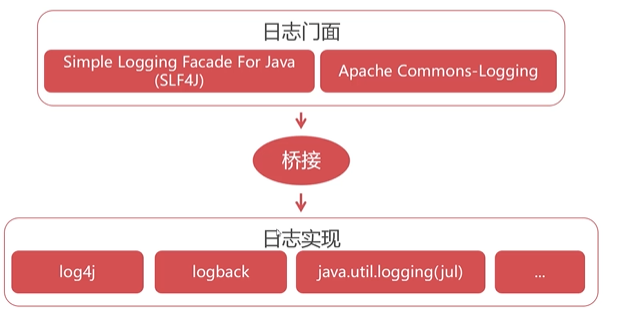
从目前的趋势来看,越来越多的开源项目从Commons-Logging加Log4j转向了SLF4J加logback。**我们在使用日志记录的时候,需要注意项目中使用的是Commons-Logging还是SLF4J,虽然切换日志实现不会造成什么影响。比如SLF4J还是Commons-Logging,都可以使用logBack作为日志实现,但是它们的接口方法的定义还是不同的。**
### logback
早期的Java项目中,基本都是使用的log4j。但是,在本教程中我们将针对logback做着重的讲解。
因为log4j和logback是近亲,这两个日志管理实现都是由一个人开发的。英文log4j虽然经过多次更新迭代,仍然有些问题积重难返,所以作者另起炉灶开发了另一款日志管理实现logback,而且logback的性能要好的多。在MyBatis底层可以通过SLF4J支持logback!
**代码实现:**
1. pom.xml增加依赖
~~~
<dependency>
<groupId>ch.qos.logback</groupId>
<artifactId>logback-classic</artifactId>
<version>1.2.3</version>
</dependency>
~~~
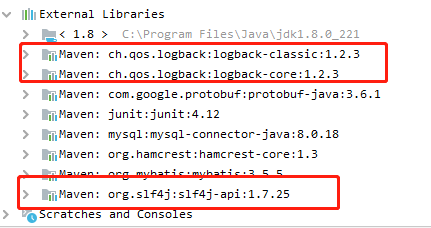
其实此时,如果我们运行测试类中方法,就会发现在控制台中就会打印日志信息了。
2. 对日志管理进行自定义设置
在resources目录下新增logback.xml文件。注意,必须叫这个名字!
~~~
<?xml version="1.0" encoding="UTF-8" ?>
<configuration>
<!-- 指定在控制台中输出日志 -->
<!-- name属性可以随意,如果要在控制台输出,一般称之为console -->
<!-- class属性指定何处打印输出 -->
<appender name="console" class="ch.qos.logback.core.ConsoleAppender">
<!-- 编码节点 -->
<encoder>
<!--
%d{HH:mm:ss.SSS}:输出时间格式,精确到毫秒
[%thread]:当前操作的线程
%-5level:以5个字符右对齐以及级别
%logger{36}:具体哪个类的日志(只显示36个字符)
%msg:日志信息
%n:换行
这些表达式在logback官网上都有详细说明
-->
<pattern>%d{HH:mm:ss.SSS} [%thread] %-5level %logger{36} - %msg%n</pattern>
</encoder>
</appender>
<!--
日志输出级别(优先级高到低):
error: 错误 - 系统的故障日志
warn: 警告 - 存在风险或使用不当的日志
info: 一般性消息
debug: 程序内部用于调试信息
trace: 程序运行的跟踪信息
下方root标签表示日志的最低输出级别为debug,即debug级别以下的信息不进行输出
-->
<root level="debug">
<appender-ref ref="console"></appender-ref>
</root>
</configuration>
~~~
## MyBatis的动态SQL
在我们使用SQL语句时,有的时候参数是不固定的。比如用户可以指定多个检索条件,也可能单独只指定一个检索条件。在这个时候,我们无法确定条件参数的数量,只能使用动态SQL完成。在实际的开发中,动态SQL的使用非常普遍。
>[success]动态SQL是指根据参数数据动态组织SQL的技术,它有些类似于对SQL执行拼接。
可以使用`<where>`标签和`<if>`组合使用,或是单独使用`<if>`标签来实现动态SQL。
~~~
<select id="dynamicSQL" parameterType="java.util.Map" resultType="com.dodoke.mybatis.entity.Goods">
select * from t_goods
<!-- 不需要写where关键字,只需要利用where标签智能判断and是否要添加 -->
<where>
<!-- 针对map中的key进行判断对应的value值是否为null和空 -->
<if test="categoryId != null and categoryId!=''">
and category_id = #{categoryId}
</if>
<if test="currentPrice != null and categoryId!=''">
and current_price < #{currentPrice}
</if>
</where>
</select>
~~~
~~~
/**
* 动态SQL语句
* @throws Exception
*/
@Test
public void testDynamicSQL() throws Exception {
SqlSession session = null;
try{
session = MyBatisUtils.openSqlSession();
Map param = new HashMap();
param.put("categoryId", 44);
param.put("currentPrice", 500);
//查询条件
List<Goods> list = session.selectList("com.dodoke.mybatis.resources.mappers.GoodsMapper.delete.dynamicSQL", param);
for(Goods g:list){
System.out.println(g.getTitle() + ":" +
g.getCategoryId() + ":" + g.getCurrentPrice());
}
}catch (Exception e){
throw e;
}finally {
MyBatisUtils.closeSqlSession(session);
}
}
~~~
## MyBatis的缓存机制
在一个项目中,查询数据库中的操作算是一个非常常用的操作,但是有些数据会被经常性的查询,而每一次都去数据库中查询这些重复的数据,会很消耗数据库的资源,同时使得查询效率也很低。
而 MyBatis 中就通过缓存技术来解决这样的问题,也就是说:将一些经常查询,并且不经常改变的,以及数据的正确对最后的结果影响不大的数据,放置在一个缓存容器中,当用户再次查询这些数据的时候,就不必再去数据库中查询,直接在缓存中提取就可以了。
>[info]注:缓存可以简单理解为存在于内存中的临时数据
在MyBatis中,存在一级缓存和二级缓存,一级缓存的效果,可以体现为同一个`sqlSession`对象操作同一条SQL时,只要参数相同就不会再去进行数据库查询,一级缓存默认开启。二级缓存需要手动开启。
关于如何使用二级缓存,可以参考如下文章,这里不再赘述,各位同学自由补充。
**参考文档:**
[https://zhuanlan.zhihu.com/p/106258135](https://zhuanlan.zhihu.com/p/106258135)
## MyBatis多表级联查询
MyBatis多表级联查询和之前学习的MyBatis多表关联查询不一样。
* 多表关联查询:两个表通过主外键在一条SQL中完成所有数据的提取。
* 多表级联查询:通过一个对象来获取与它关联的另外一个对象,执行的SQL语句分为多条。
**确定对象之间的关系是双向的:**
双向的一对多,应该变成多对多,在进行数据库设计的时候需要单独抽象出一张中间表来!!!
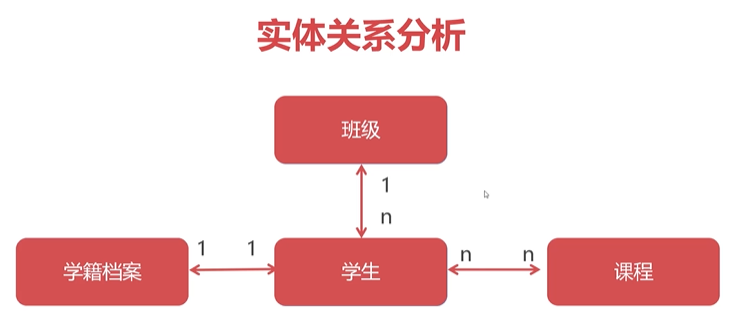
### 一对多关联查询
案例:要求查询某件商品的详细信息
1. 新建实体类
~~~
package com.dodoke.mybatis.entity;
public class GoodsDetail {
private Integer gdId;
private Integer goodsId;
private String gdPicUrl;
private Integer gdOrder;
public Integer getGdId() {
return gdId;
}
public void setGdId(Integer gdId) {
this.gdId = gdId;
}
public Integer getGoodsId() {
return goodsId;
}
public void setGoodsId(Integer goodsId) {
this.goodsId = goodsId;
}
public String getGdPicUrl() {
return gdPicUrl;
}
public void setGdPicUrl(String gdPicUrl) {
this.gdPicUrl = gdPicUrl;
}
public Integer getGdOrder() {
return gdOrder;
}
public void setGdOrder(Integer gdOrder) {
this.gdOrder = gdOrder;
}
}
~~~
2. 新建mapper xml文件 `GoodsDetailMapper.xml`
~~~
<?xml version="1.0" encoding="UTF-8"?>
<!DOCTYPE mapper
PUBLIC "-//mybatis.org//DTD Mapper 3.0//EN"
"http://mybatis.org/dtd/mybatis-3-mapper.dtd">
<mapper namespace="goodsDetail">
<select id="selectByGoodsId" parameterType="Integer"
resultType="com.dodoke.mybatis.entity.GoodsDetail">
select * from t_goods_detail where goods_id = #{value}
</select>
</mapper>
~~~
3. 修改Goods类,为体现一对多的关系,新增一个属性
~~~
/**
* 数据库t_goods表对应映射的实体类
*/
public class Goods {
private Integer goodsId;//商品编号
private String title;//标题
private String subTitle;//子标题
private Float originalCost;//原始价格
private Float currentPrice;//当前价格
private Float discount;//折扣率
private Integer isFreeDelivery;//是否包邮 ,1-包邮 0-不包邮
private Integer categoryId;//分类编号
private List<GoodsDetail> goodsDetails;
public List<GoodsDetail> getGoodsDetails() {
return goodsDetails;
}
public void setGoodsDetails(List<GoodsDetail> goodsDetails) {
this.goodsDetails = goodsDetails;
}
public Integer getGoodsId() {
return goodsId;
}
public void setGoodsId(Integer goodsId) {
this.goodsId = goodsId;
}
public String getTitle() {
return title;
}
public void setTitle(String title) {
this.title = title;
}
public String getSubTitle() {
return subTitle;
}
public void setSubTitle(String subTitle) {
this.subTitle = subTitle;
}
public Float getOriginalCost() {
return originalCost;
}
public void setOriginalCost(Float originalCost) {
this.originalCost = originalCost;
}
public Float getCurrentPrice() {
return currentPrice;
}
public void setCurrentPrice(Float currentPrice) {
this.currentPrice = currentPrice;
}
public Float getDiscount() {
return discount;
}
public void setDiscount(Float discount) {
this.discount = discount;
}
public Integer getIsFreeDelivery() {
return isFreeDelivery;
}
public void setIsFreeDelivery(Integer isFreeDelivery) {
this.isFreeDelivery = isFreeDelivery;
}
public Integer getCategoryId() {
return categoryId;
}
public void setCategoryId(Integer categoryId) {
this.categoryId = categoryId;
}
}
~~~
4. 利用resultMap实现一对多映射,GoodsMapper.xml
~~~
<!--
resultMap可用于说明一对多或者多对一的映射逻辑
id 是resultMap属性引用的标志
type 指向One的实体(Goods)
-->
<resultMap id="rmGoods1" type="com.dodoke.mybatis.entity.Goods">
<!-- 映射goods对象的主键到goods_id字段 -->
<id column="goods_id" property="goodsId"></id>
<!--
collection的含义是,在
select * from t_goods limit 0,10 得到结果后,对所有Goods对象遍历得到goods_id字段值,
并代入到goodsDetail命名空间的findByGoodsId的SQL中执行查询,
将得到的"商品详情"集合赋值给goodsDetails List对象.
-->
<collection property="goodsDetails" select="goodsDetail.selectByGoodsId"
column="goods_id"/>
</resultMap>
<select id="selectOneToMany" resultMap="rmGoods1">
select * from t_goods limit 0,10
</select>
~~~
5. 编写测试方法
~~~
/**
* 一对多对象关联查询
* @throws Exception
*/
@Test
public void testOneToMany() throws Exception {
SqlSession session = null;
try {
session = MyBatisUtils.openSqlSession();
List<Goods> list = session.selectList("com.dodoke.mybatis.resources.mappers.GoodsMapper.selectOneToMany");
for(Goods goods:list) {
System.out.println(goods.getTitle() + ":" + goods.getGoodsDetails().size());
}
} catch (Exception e) {
throw e;
} finally {
MyBatisUtils.closeSqlSession(session);
}
}
~~~
### 多对一关联查询
当多对一的时候,只需要在多的一方实体类中,持有一的一方的实体!
即:
~~~
package com.dodoke.mybatis.entity;
public class GoodsDetail {
private Integer gdId;
private Integer goodsId;
private String gdPicUrl;
private Integer gdOrder;
private Goods goods;//添加goods类属性
public Integer getGdId() {
return gdId;
}
public void setGdId(Integer gdId) {
this.gdId = gdId;
}
public Integer getGoodsId() {
return goodsId;
}
public void setGoodsId(Integer goodsId) {
this.goodsId = goodsId;
}
public String getGdPicUrl() {
return gdPicUrl;
}
public void setGdPicUrl(String gdPicUrl) {
this.gdPicUrl = gdPicUrl;
}
public Integer getGdOrder() {
return gdOrder;
}
public void setGdOrder(Integer gdOrder) {
this.gdOrder = gdOrder;
}
public Goods getGoods() {
return goods;
}
public void setGoods(Goods goods) {
this.goods = goods;
}
}
~~~
修改GoodsDetailMapper.xml
~~~
<?xml version="1.0" encoding="UTF-8"?>
<!DOCTYPE mapper
PUBLIC "-//mybatis.org//DTD Mapper 3.0//EN"
"http://mybatis.org/dtd/mybatis-3-mapper.dtd">
<mapper namespace="goodsDetail">
<select id="selectByGoodsId" parameterType="Integer"
resultType="com.dodoke.mybatis.entity.GoodsDetail">
select * from t_goods_detail where goods_id = #{value}
</select>
<resultMap id="rmGoodsDetail" type="com.dodoke.mybatis.entity.GoodsDetail">
<!-- 除了id,只有其它的属性符合驼峰命名规则就不需要填写大量的result标签 -->
<id column="gd_id" property="gdId"/>
<!-- 因为在下方使用了goods属性,导致goods_id没有对goodsId进行正确赋值,所以需要进行手动赋值 -->
<result column="goods_id" property="goodsId"/>
<!-- 该标签表示从多的一方关联到一的一方 -->
<association property="goods" select="com.dodoke.mybatis.resources.mappers.GoodsMapper.selectById" column="goods_id"></association>
</resultMap>
<select id="selectManyToOne" resultMap="rmGoodsDetail">
select * from t_goods_detail limit 0,20
</select>
</mapper>
~~~
## MyBatis整合C3P0连接池
在之前的课程中,我们就使用过连接池。而且在mybatis-config.xml文件中也设置了使用数据库连接池,但是这个数据库连接池是使用的MyBatis自带的数据库连接池。我们希望使用更好的数据库连接池,可以采用C3P0连接池替换掉自带连接池。
pom.xml中添加依赖
~~~
<dependency>
<groupId>com.mchange</groupId>
<artifactId>c3p0</artifactId>
<version>0.9.5.2</version>
</dependency>
~~~
新增一个C3P0DataSourceFactory扩展类
~~~
package com.dodoke.mybatis.datasources;
import com.mchange.v2.c3p0.ComboPooledDataSource;
import org.apache.ibatis.datasource.unpooled.UnpooledDataSourceFactory;
/**
* C3P0与MyBatis兼容使用的数据源工厂类
* 继承UnpooledDataSourceFactory类实现C3P0的迁入工作。
*/
public class C3P0DataSourceFactory extends UnpooledDataSourceFactory {
public C3P0DataSourceFactory(){
//指UnpooledDataSourceFactory类的数据源由C3P0提供
this.dataSource = new ComboPooledDataSource();
}
}
~~~
修改mybatis-config.xml,type改成指向新增的类:C3P0DataSourceFactory
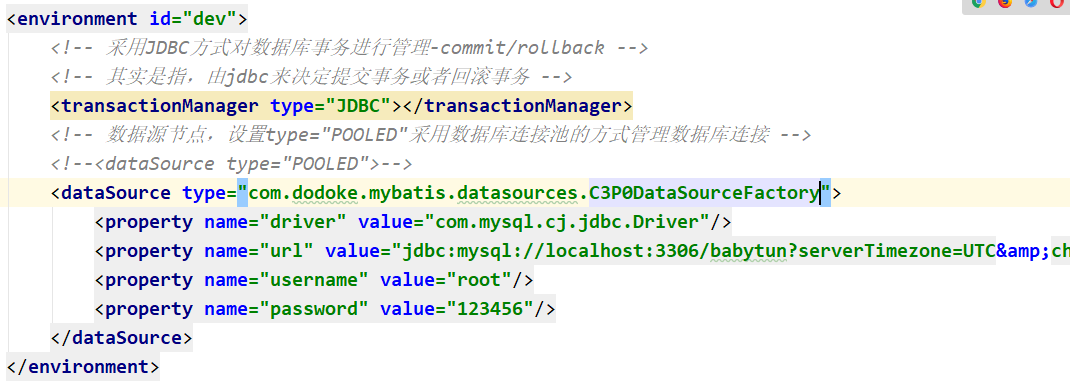
修改C3P0属性值
~~~
<!--<dataSource type="POOLED">-->
<dataSource type="com.dodoke.mybatis.datasources.C3P0DataSourceFactory">
<property name="driverClass" value="com.mysql.cj.jdbc.Driver"/>
<property name="jdbcUrl" value="jdbc:mysql://localhost:3306/babytun?serverTimezone=UTC&characterEncoding=UTF-8"/>
<property name="user" value="root"/>
<property name="password" value="123456"/>
<property name="initialPoolSize" value="5"/>
<property name="maxPoolSize" value="20"/>
<property name="minPoolSize" value="5"/>
</dataSource>
~~~
## MyBatis的批量处理
MyBatis的批量处理实际上就是通过循环实现SQL的批量执行
~~~
<!--INSERT INTO table-->
<!--VALUES ("a" , "a1" , "a2"),("b" , "b1" , "b2"),(....)-->
<insert id="batchInsert" parameterType="java.util.List">
INSERT INTO t_goods(title, sub_title, original_cost, current_price, discount, is_free_delivery, category_id)
VALUES
<foreach collection="list" item="item" index="index" separator=",">
(#{item.title},#{item.subTitle}, #{item.originalCost}, #{item.currentPrice}, #{item.discount}, #{item.isFreeDelivery}, #{item.categoryId})
</foreach>
</insert>
<!--in (1901,1902)-->
<delete id="batchDelete" parameterType="java.util.List">
DELETE FROM t_goods WHERE goods_id in
<foreach collection="list" item="item" index="index" open="(" close=")" separator=",">
#{item}
</foreach>
</delete>
~~~
* collection="list"代表迭代的数据源从哪来,一般情况下书写list,指代从外侧传来的List集合,这个名字是mybatis强制要求不能随意修改
* item="item" 循环中的迭代遍历
* indx="index" 循环的索引,当前是第几次循环
* separator="," 分割器,生成文本时(("a","a1","a2"),("b","b1","b2"),...),每个记录用逗号分割
* 批量删除中传入的list中包含的是每一个要删除的数据的编号,foreach标签中要加入open="(" close=")"
~~~
/**
* 批量插入测试
* @throws Exception
*/
@Test
public void testBatchInsert() throws Exception {
SqlSession session = null;
try {
long st = new Date().getTime();
session = MyBatisUtils.openSqlSession();
List list = new ArrayList();
for (int i = 0; i < 10000; i++) {
Goods goods = new Goods();
goods.setTitle("测试商品");
goods.setSubTitle("测试子标题");
goods.setOriginalCost(200f);
goods.setCurrentPrice(100f);
goods.setDiscount(0.5f);
goods.setIsFreeDelivery(1);
goods.setCategoryId(43);
//insert()方法返回值代表本次成功插入的记录总数
list.add(goods);
}
session.insert("goods.batchInsert", list);
session.commit();//提交事务数据
long et = new Date().getTime();
System.out.println("执行时间:" + (et - st) + "毫秒");
// System.out.println(goods.getGoodsId());
} catch (Exception e) {
if (session != null) {
session.rollback();//回滚事务
}
throw e;
} finally {
MyBatisUtils.closeSqlSession(session);
}
}
/**
* 10000次数据插入对比测试用例
* @throws Exception
*/
@Test
public void testInsert1() throws Exception {
SqlSession session = null;
try{
long st = new Date().getTime();
session = MyBatisUtils.openSqlSession();
List list = new ArrayList();
for(int i = 0 ; i < 10000 ; i++) {
Goods goods = new Goods();
goods.setTitle("测试商品");
goods.setSubTitle("测试子标题");
goods.setOriginalCost(200f);
goods.setCurrentPrice(100f);
goods.setDiscount(0.5f);
goods.setIsFreeDelivery(1);
goods.setCategoryId(43);
//insert()方法返回值代表本次成功插入的记录总数
session.insert("goods.insert" , goods);
}
session.commit();//提交事务数据
long et = new Date().getTime();
System.out.println("执行时间:" + (et-st) + "毫秒");
// System.out.println(goods.getGoodsId());
}catch (Exception e){
if(session != null){
session.rollback();//回滚事务
}
throw e;
}finally {
MyBatisUtils.closeSqlSession(session);
}
}
/**
* 批量删除测试
* @throws Exception
*/
@Test
public void testBatchDelete() throws Exception {
SqlSession session = null;
try {
long st = new Date().getTime();
session = MyBatisUtils.openSqlSession();
List list = new ArrayList();
list.add(1920);
list.add(1921);
list.add(1922);
session.delete("goods.batchDelete", list);
session.commit();//提交事务数据
long et = new Date().getTime();
System.out.println("执行时间:" + (et - st) + "毫秒");
// System.out.println(goods.getGoodsId());
} catch (Exception e) {
if (session != null) {
session.rollback();//回滚事务
}
throw e;
} finally {
MyBatisUtils.closeSqlSession(session);
}
}
~~~
**批量插入数据的局限,需要通过压力测试来调整**
1. 无法获得插入的数据id
2. 批量生成的SQL太长,可能会被服务器拒绝。
## 对MyBatis中使用到的类起别名
之前,我们在 mapper xml 文件中的引用实体类时,需要写上实体类的全类名(包名+类名),每次都写这么一长串内容挺麻烦的,而我们希望能够采用一种简写的形式。比如写成这种形式就挺舒服的。
~~~
<select id="selectAll" resultType="_Goods">
select * from t_goods order by goods_id desc limit 10
</select>
~~~
可以在mybatis-config.xml标签中添加`typeAliases`,注意添加位置。

~~~
<settings>
<!-- 驼峰命名转化设置 -->
<!-- 该设置表示将数据库中表的字段,比如goods_id => goodsId -->
<setting name="mapUnderscoreToCamelCase" value="true"/>
</settings>
<typeAliases>
<typeAlias type="com.dodoke.mybatis.entity.Goods" alias="_Goods"/>
</typeAliases>
~~~
## Mybatis使用注解进行开发
对于Mybatis而言,它提供了一种使用注解的开发方式,这种开发方式与使用xml进行开发比较,它更适合使用在一些小型敏捷的项目中。
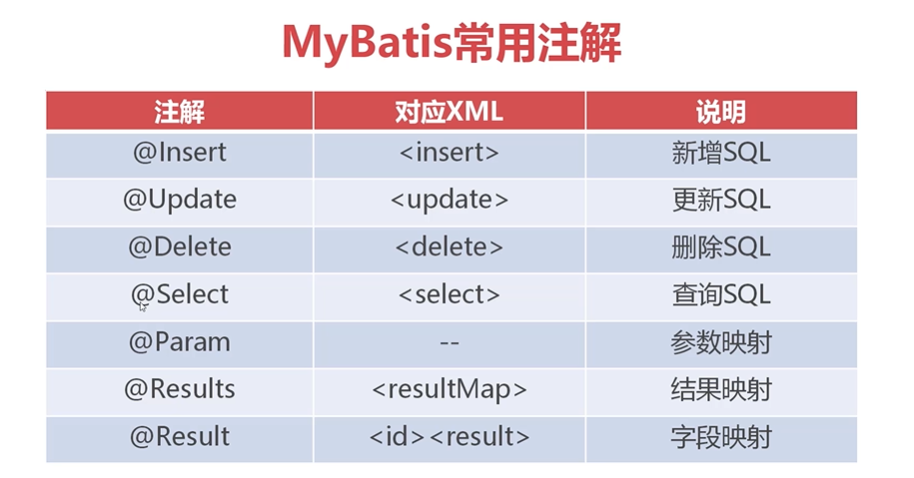
在之前的项目基础上新建一个项目:(pom.xml中依赖不变,工具类不变,logback自定义文件不变)

**mybatis-config.xml**
~~~
<?xml version="1.0" encoding="utf-8" ?>
<!-- 官网复制DTD约束 -->
<!DOCTYPE configuration
PUBLIC "-//mybatis.org//DTD Config 3.0//EN"
"http://mybatis.org/dtd/mybatis-3-config.dtd">
<!-- 设置根节点 -->
<configuration>
<settings>
<!-- 驼峰命名转化设置 -->
<setting name="mapUnderscoreToCamelCase" value="true"/>
</settings>
<environments default="dev">
<environment id="dev">
<transactionManager type="JDBC"></transactionManager>
<!-- 数据源节点,设置type="POOLED"采用数据库连接池的方式管理数据库连接 -->
<dataSource type="POOLED">
<property name="driver" value="com.mysql.cj.jdbc.Driver"/>
<property name="url" value="jdbc:mysql://localhost:3306/babytun?serverTimezone=UTC&characterEncoding=UTF-8"/>
<property name="username" value="root"/>
<property name="password" value="123456"/>
</dataSource>
</environment>
</environments>
<mappers>
<!-- mybatis如果使用注解开发,需要将接口当做mapper xml 进行注册-->
<!--<mapper class="com.dodoke.mybatisannotation.dao.GoodsDao"/>-->
<!-- 可以通过package标签将该包中接口全部注册 -->
<package name="com.dodoke.mybatisannotation.dao"/>
</mappers>
</configuration>
~~~
**实体类**
~~~
public class Goods {
private Integer goodsId;//商品编号
private String title;//标题
private String subTitle;//子标题
private Float originalCost;//原始价格
private Float currentPrice;//当前价格
private Float discount;//折扣率
private Integer isFreeDelivery;//是否包邮 ,1-包邮 0-不包邮
private Integer categoryId;//分类编号
public Integer getGoodsId() {
return goodsId;
}
public void setGoodsId(Integer goodsId) {
this.goodsId = goodsId;
}
public String getTitle() {
return title;
}
public void setTitle(String title) {
this.title = title;
}
public String getSubTitle() {
return subTitle;
}
public void setSubTitle(String subTitle) {
this.subTitle = subTitle;
}
public Float getOriginalCost() {
return originalCost;
}
public void setOriginalCost(Float originalCost) {
this.originalCost = originalCost;
}
public Float getCurrentPrice() {
return currentPrice;
}
public void setCurrentPrice(Float currentPrice) {
this.currentPrice = currentPrice;
}
public Float getDiscount() {
return discount;
}
public void setDiscount(Float discount) {
this.discount = discount;
}
public Integer getIsFreeDelivery() {
return isFreeDelivery;
}
public void setIsFreeDelivery(Integer isFreeDelivery) {
this.isFreeDelivery = isFreeDelivery;
}
public Integer getCategoryId() {
return categoryId;
}
public void setCategoryId(Integer categoryId) {
this.categoryId = categoryId;
}
@Override
public String toString() {
return "Goods{" +
"goodsId=" + goodsId +
", title='" + title + '\'' +
", subTitle='" + subTitle + '\'' +
", originalCost=" + originalCost +
", currentPrice=" + currentPrice +
", discount=" + discount +
", isFreeDelivery=" + isFreeDelivery +
", categoryId=" + categoryId +
'}';
}
}
~~~
**数据传输类**
~~~
package com.dodoke.mybatisannotation.dto;
public class GoodsDTO {
private int goodsId;
private String title;
private String subTitle;
public int getGoodsId() {
return goodsId;
}
public void setGoodsId(int goodsId) {
this.goodsId = goodsId;
}
public String getTitle() {
return title;
}
public void setTitle(String title) {
this.title = title;
}
public String getSubTitle() {
return subTitle;
}
public void setSubTitle(String subTitle) {
this.subTitle = subTitle;
}
@Override
public String toString() {
return "GoodsDTO{" +
"goodsId=" + goodsId +
", title='" + title + '\'' +
", subTitle='" + subTitle + '\'' +
'}';
}
}
~~~
**接口注解开发-接口**
~~~
package com.dodoke.mybatisannotation.dao;
import com.dodoke.mybatisannotation.dto.GoodsDTO;
import com.dodoke.mybatisannotation.entity.Goods;
import org.apache.ibatis.annotations.*;
import java.util.List;
import java.util.Map;
/**
* 该接口用操作数据库
*/
public interface GoodsDao {
@Select("select * from t_goods where current_price between #{min} and #{max} order by current_price limit 0,#{limt}")
public List<Goods> selectByPriceRange(@Param("min") Float min, @Param("max") Float max, @Param("limt") Integer limt);
/**
* 对于注解开发来说,新增和删除,以及修改方法的返回值都要是int类型
* @param goods
* @return
*/
@Insert("INSERT INTO t_goods(title, sub_title, original_cost, current_price, discount, is_free_delivery, category_id) VALUES (#{title} , #{subTitle} , #{originalCost}, #{currentPrice}, #{discount}, #{isFreeDelivery}, #{categoryId})")
@SelectKey(statement = "select last_insert_id()" ,before=false,keyProperty = "goodsId" ,resultType = Integer.class)
public int insert(Goods goods);
@Select(" select * from t_goods order by goods_id desc limit 10")
//如果没有设置驼峰命令转换或者要设置数据转换类,或者多对一,一对多的时候,可以利用results注解
@Results({
//设置id=true,明确指示id属性
@Result(column = "goods_id",property = "goodsId" , id=true),
@Result(column = "title",property = "title" ),
@Result(column = "sub_title",property = "subTitle" ),
})
public List<GoodsDTO> selectLimit();
}
~~~
